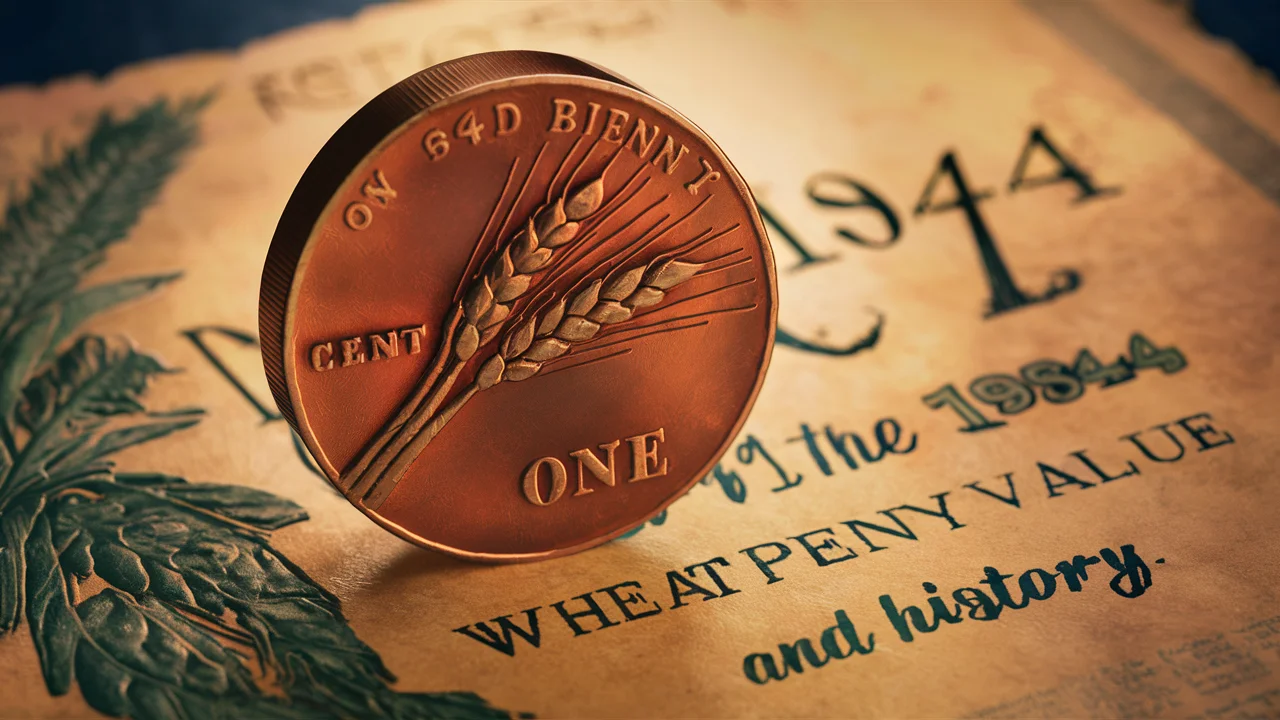Introduction
The 1944 Wheat Penny, also known as the 1944 Lincoln Cent, holds a special place in the hearts of coin collectors and history enthusiasts alike. This small copper coin, minted during the tumultuous years of World War II, tells a fascinating story of American resilience and ingenuity. As we delve into the rich history and value of this numismatic treasure, we’ll uncover why the 1944 Wheat Penny continues to captivate collectors and investors today.
Key points about the 1944 Wheat Penny:
- Minted during World War II, reflecting wartime economic conditions
- Part of the broader Lincoln cent series, featuring the iconic wheat reverse design
- Valued for both its historical significance and potential numismatic worth
The 1944 penny’s worth extends far beyond its face value, with some rare specimens fetching impressive sums at auction. Whether you’re a seasoned coin collector or a curious history buff, understanding the nuances of this coin can enhance your appreciation of American numismatic heritage. In this comprehensive guide, we’ll explore the historical context, physical characteristics, minting details, and current market value of the 1944 Wheat Penny.
By the end of this article, you’ll have a deeper understanding of:
- The historical events that shaped the production of the 1944 Wheat Penny
- How to identify and grade these coins
- The factors that influence their value in today’s collector’s market
Join us on this numismatic journey as we uncover the secrets and stories hidden within the humble 1944 Wheat Cent, a small piece of copper that carries the weight of American history.
Historical Context

The 1944 Wheat Penny emerged during a pivotal moment in American history, as World War II reshaped the nation’s economy and industry. This Lincoln cent, with its distinctive wheat stalks reverse design, serves as a tangible link to the wartime era. Understanding the historical backdrop is crucial to appreciating the significance of this coin in U.S. coin history.
World War II’s Impact on U.S. Coinage:
- Metals like copper were crucial for the war effort, affecting coin production
- The U.S. Mint had to balance coinage needs with wartime material shortages
- Penny production remained high due to increased economic activity
In 1944, the United States was in the midst of its third full year of involvement in World War II. The war effort demanded vast quantities of strategic metals, including copper, which was essential for ammunition production. Despite these pressures, the government recognized the importance of maintaining a steady supply of coins to support the booming wartime economy.
The role of pennies in the wartime economy cannot be overstated. With rationing in effect and many consumer goods unavailable, every cent counted in household budgets. Pennies were crucial for making change, paying sales taxes, and operating vending machines. This high demand led to substantial mintage numbers for the 1944 Wheat Penny across all three mints: Philadelphia, Denver, and San Francisco.
Interestingly, the composition of the 1944 penny remained unchanged from its pre-war formula, despite experiments with alternative materials for other coins. The Lincoln cent continued to be struck in 95% copper and 5% zinc and tin. This consistency in composition adds to the coin’s historical value, as it represents one of the few aspects of American life that remained constant during the turbulent war years.
The 1944 Wheat Penny also reflects the artistic continuity maintained throughout this period. The obverse, featuring Victor D. Brenner’s iconic portrait of Abraham Lincoln, and the reverse, with its simple yet elegant wheat stalks design, remained unchanged. This stability in design served as a small but significant symbol of American perseverance in the face of global conflict.
Collectors and historians alike value the 1944 Wheat Penny not just for its potential monetary worth, but for its role as a historical artifact. Each coin tells a story of a nation at war, of families counting every penny, and of a monetary system adapting to extraordinary circumstances. As we examine these pennies today, we hold in our hands a direct connection to one of the most significant periods in American history.
Design and Features

The 1944 Wheat Penny, like its predecessors in the Lincoln cent series, boasts a design rich in symbolism and historical significance. Understanding its design elements and physical characteristics is crucial for both collectors and enthusiasts interested in U.S. coin history.
Obverse Design:
- Portrait of Abraham Lincoln, facing right
- Inscriptions: “IN GOD WE TRUST” (above), “LIBERTY” (left), Date: “1944” (below)
The obverse of the 1944 Wheat cent features the iconic portrait of Abraham Lincoln, designed by Victor David Brenner in 1909. This bust of Lincoln was based on a photograph taken by Anthony Berger in 1864, capturing the 16th president’s likeness during the Civil War. The inclusion of Lincoln on the penny was a tribute to the centennial of his birth and marked the first time a real person appeared on a circulating U.S. coin.
Brenner’s initials, VDB, which caused controversy when first added to the coin in 1909, are absent from the 1944 issue. They had been removed from the coin’s reverse in 1909 and would not reappear until 1918, when they were discreetly added to the obverse, below Lincoln’s shoulder.
Reverse Design:
- Two wheat stalks framing the denomination and country name
- Inscriptions: “ONE CENT” (center), “UNITED STATES OF AMERICA” (top), “E PLURIBUS UNUM” (bottom)
The reverse of the 1944 penny features the “Wheat Ears” design, which gave this series its popular name. Created by Brenner, this simple yet elegant design consists of two wheat stalks framing the central inscriptions. The wheat symbolizes national prosperity and agricultural heritage, resonating deeply with the American public during its 50-year run from 1909 to 1958.
Physical Specifications:
- Diameter: 19.05 mm
- Weight: 3.11 grams
- Composition: 95% copper, 5% tin and zinc
- Edge: Plain
The 1944 Wheat Penny maintained the same specifications as pre-war cents, despite material shortages during World War II. This consistency in size and weight was crucial for vending machines and other coin-operated devices of the era.
Mint Marks:
- Philadelphia: No mint mark
- Denver: “D” mint mark
- San Francisco: “S” mint mark
Mint marks, when present, are located below the date on the obverse. The absence of a mint mark indicates production at the Philadelphia Mint.
The design elements of the 1944 Wheat Penny, from Lincoln’s portrait to the wheat stalks, encapsulate American ideals of unity, prosperity, and perseverance. These symbols resonated strongly during the challenging years of World War II, making the 1944 issue particularly poignant. For collectors, understanding these design features is key to authenticating and appreciating these historical coins.
Minting Information

The production of the 1944 Wheat Penny occurred across three U.S. Mint facilities, resulting in substantial mintage figures that reflect the high demand for coins during World War II. Understanding the minting details provides crucial context for collectors assessing the rarity and value of these pennies.
Mint Locations and Mintage Figures:
- Philadelphia: 1,435,400,000 (no mint mark)
- Denver: 430,578,000 (D mint mark)
- San Francisco: 282,760,000 (S mint mark)
The Philadelphia Mint, as the primary facility, produced the highest number of 1944 Wheat cents. This enormous output of over 1.4 billion coins ensured an ample supply for the war-driven economy. Denver and San Francisco, while producing fewer coins, still contributed significantly to the overall mintage.
Identifying Mint Marks:
- Location: Below the date on the obverse side
- Size: Small but visible to the naked eye
- Absent on Philadelphia-minted coins
Mint marks are crucial for coin identification and can significantly affect a penny’s value. The “D” for Denver and “S” for San Francisco are stamped clearly, though coins from these mints are generally less common than their Philadelphia counterparts.
Production Process:
- Blanks (planchets) cut from copper sheets
- Struck using high-pressure dies
- Quality control measures in place despite high-speed production
Despite the pressures of wartime production, the U.S. Mint maintained high standards for the 1944 Wheat Penny. However, the rapid pace of minting did lead to some variations and errors, which are highly prized by collectors today.
Notable Production Aspects:
- Consistent metal composition despite wartime shortages
- High-speed minting to meet economic demands
- Potential for die errors increased due to accelerated production
The sheer volume of 1944 pennies minted means that many survived in circulation for decades, making them relatively accessible to modern collectors. However, finding specimens in pristine condition remains a challenge, adding to the appeal for serious numismatists.
Historical Production Context:
- Coin production prioritized to support wartime economy
- Pennies needed for exact change due to rationing and price controls
- Mints operated at near-maximum capacity throughout 1944
The massive mintage of 1944 Wheat Pennies reflects the unique economic conditions of World War II. With manufacturing focused on the war effort and many consumer goods unavailable, coins played a crucial role in daily transactions and savings.
For collectors, understanding these minting details is essential. While the high mintage figures mean that 1944 Wheat Pennies are generally not rare, certain factors like mint mark, condition, and potential errors can make individual coins highly valuable. This minting information forms the foundation for assessing the numismatic worth of these historical artifacts.
Varieties and Errors

While the 1944 Wheat Penny was produced in large quantities, certain varieties and errors make some specimens particularly valuable to collectors. Understanding these variations is crucial for identifying potentially rare and valuable coins within this common issue.
Common Varieties:
- Repunched Mint Mark (RPM) • Most common on Denver and San Francisco issues • Visible doubling or shifting of the mint mark • Caused by multiple strikes of the mint mark punch
- Doubled Die (DD) • Can affect obverse or reverse • Shows doubling in lettering or design elements • Results from misalignment during the hub and die creation process
- Off-Center Strikes • Part of the design missing due to misalignment during striking • Value increases with the degree of off-center striking • Must retain full date to be most desirable
Notable Errors:
- 1944 Steel Cent • Extremely rare – possibly struck on leftover 1943 steel planchets • Only a handful known to exist • Highly valuable due to rarity and historical significance
- Clipped Planchet • Missing a portion of the coin due to improper cutting of the blank • Can be straight clip or curved clip varieties • Value depends on the extent and location of the clip
- Die Cracks and Cuds • Result from worn or damaged dies • Appear as raised lines or lumps on the coin’s surface • Large cuds can be quite valuable
Identifying Varieties and Errors:
- Use a magnifying glass or coin loupe for close examination
- Compare against known normal specimens
- Check reference guides for authenticated varieties
- Look for inconsistencies in lettering, design elements, or overall shape
Causes of Varieties and Errors:
- High-speed production to meet wartime demand
- Worn equipment due to constant use
- Potential lapses in quality control during wartime operations
Impact on Value:
- Minor varieties may command slight premiums
- Major errors, especially the 1944 Steel Cent, can be extremely valuable
- Condition plays a crucial role in determining value of error coins
For collectors, these varieties and errors add an extra layer of excitement to the hunt for 1944 Wheat Pennies. While most 1944 cents are common, the possibility of finding a rare variety or significant error keeps the search interesting. It’s important to note that authentication is crucial for valuable errors, as some can be easily faked.
Remember, just because a coin looks unusual doesn’t necessarily mean it’s a valuable error. Many marks or oddities can be the result of post-mint damage. When in doubt, consult with a professional numismatist or consider getting the coin certified by a reputable grading service.
The study of varieties and errors in the 1944 Wheat Penny not only adds depth to a collection but also provides insight into the minting process during a critical period in American history.
Condition and Grading

The condition of a 1944 Wheat Penny plays a crucial role in determining its value and collectibility. Understanding the grading process and key areas to examine for wear is essential for both collectors and sellers in the numismatic market.
Coin Grading Scales:
- Sheldon Scale • Ranges from Poor (P-1) to Perfect Mint State (MS-70) • Most commonly used for circulated coins
- PCGS and NGC Scale • Focuses on Mint State coins (MS-60 to MS-70) • Used by professional grading services
Key Grades for 1944 Wheat Pennies:
- Good (G-4): Heavy wear, but major features still visible
- Fine (F-12): Moderate wear, all lettering clear
- Extremely Fine (EF-40): Light wear, some luster remaining
- About Uncirculated (AU-50 to AU-58): Minimal wear, most luster intact
- Mint State (MS-60 to MS-70): No wear, varying degrees of luster and contact marks
Key Areas to Examine for Wear:
- Obverse (Front): • Lincoln’s cheek and jaw • Hair details above the ear • Facial features, especially the eye and beard
- Reverse (Back): • Wheat stalks, particularly the fine lines • Lettering, especially “ONE CENT” • Overall sharpness of design elements
Factors Affecting Condition:
- Circulation: Length of time in general use
- Storage: Exposure to environmental factors
- Handling: Improper cleaning or physical damage
Impact of Condition on Value:
- Circulated coins (G-4 to AU-58) generally have modest value
- Mint State coins (MS-60+) can command significant premiums
- Red (RD), Red-Brown (RB), and Brown (BN) color designations affect value in Mint State
Preservation Tips:
- Handle coins by the edges to avoid fingerprints
- Store in non-reactive holders (avoid PVC)
- Maintain consistent temperature and humidity
Professional Grading:
- Consider professional grading for high-grade or valuable specimens
- Provides authentication and protection
- Enhances marketability and value certainty
For the 1944 Wheat Penny, condition is particularly important due to its high mintage. While circulated examples are common, well-preserved Mint State coins, especially those with original red color, can be quite valuable. Collectors should strive to acquire the best condition they can afford, as even small differences in grade can result in significant value variations.
Remember, grading is both an art and a science. While guidelines exist, there can be subtle differences in opinion between graders. For valuable coins, third-party grading from respected services like PCGS or NGC can provide an objective assessment and protection against counterfeit or altered coins.
Understanding coin grading and condition assessment is a skill that develops with experience. Studying reference materials, examining many coins, and seeking advice from experienced collectors or dealers can help refine this crucial numismatic skill.
Value and Collectibility

The value of a 1944 Wheat Penny can vary significantly based on several factors. Understanding these factors and current market trends is essential for collectors and investors alike.
Factors Affecting Value:
- Condition (Grade) • Higher grades generally command higher prices • Mint State coins with original red color are most valuable
- Mint Mark • Philadelphia (no mark) issues are most common • Denver (D) and San Francisco (S) can be slightly more valuable
- Varieties and Errors • Rare errors like the 1944 Steel Cent are highly valuable • Minor varieties may add modest premiums
- Overall Market Demand • Fluctuates based on collector interest and economic factors
Current Market Values (as of 2024):
Note: These are approximate values and can fluctuate. Always check current market prices.
- Circulated conditions (Good to Extremely Fine): $0.05 to $2
- About Uncirculated: $3 to $10
- Mint State (MS-60 to MS-63): $10 to $30
- Mint State (MS-64 to MS-66): $30 to $100
- Mint State (MS-67 and above): $100 to $1000+
Red (RD) specimens in high Mint State grades can command significant premiums over Brown (BN) or Red-Brown (RB) examples.
Comparison to Other Wheat Penny Years:
- Generally more common than wartime steel cents (1943)
- Less valuable than key dates like 1909-S VDB or 1914-D
- Similar in value to most other 1940s issues
Trends in Collectibility:
- Steady demand from Lincoln cent series collectors
- Popular as an affordable entry point for new collectors
- Increasing interest in high-grade, original red specimens
Investment Potential:
- Not typically considered a high-yield investment
- Value tends to keep pace with inflation for high-grade examples
- More valuable as part of a complete collection than as individual coins
Factors Driving Demand:
- Historical significance of the World War II era
- Relative affordability compared to rarer dates
- Popularity of the Lincoln cent series among collectors
Tips for Buyers:
- Focus on condition – seek the best grade you can afford
- Be wary of cleaned or altered coins
- Consider certified coins for higher-value purchases
- Research current market prices before making significant purchases
Tips for Sellers:
- Have realistic expectations based on current market values
- Consider professional grading for high-grade or potentially valuable specimens
- Provide clear, accurate descriptions and photos when listing coins
The 1944 Wheat Penny, while common in circulated grades, remains an important part of many collections. Its historical context and the potential for finding valuable varieties or high-grade specimens keep it relevant in the numismatic market. For most collectors, the value of this coin lies more in its historical significance and role in completing a set than in its monetary worth. However, for those lucky enough to find pristine examples or rare errors, the 1944 Wheat Penny can be a valuable numismatic treasure.
Preservation and Care

Proper preservation and care are crucial for maintaining the condition and value of 1944 Wheat Pennies. Whether you’re a seasoned collector or new to numismatics, following these guidelines will help protect your coins for years to come.
Proper Handling Techniques:
- Always hold coins by their edges
- Use clean, lint-free cotton gloves when possible
- Avoid touching the face of the coin to prevent fingerprints
- Handle over a soft surface to minimize damage from accidental drops
Storage Recommendations:
- Coin Folders and Albums • Good for organizing collections • Provide some protection but may not be airtight
- Individual Coin Flips • Inexpensive option for single coins • Choose non-PVC flips to avoid chemical reactions
- Coin Capsules • Offer excellent protection against environmental factors • Available in various sizes to ensure a snug fit
- Slabs (for valuable specimens) • Professional grading companies provide tamper-evident holders • Offer maximum protection and authentication
Environmental Considerations:
- Store coins in a cool, dry place
- Avoid areas with high humidity to prevent corrosion
- Keep away from direct sunlight to prevent color changes
- Maintain consistent temperature to avoid expansion and contraction
Cleaning (and why it’s generally discouraged):
- Improper cleaning can significantly reduce a coin’s value
- Natural toning is often desirable to collectors
- If cleaning is absolutely necessary:
- Use only distilled water
- Pat dry gently, never rub
- Consider professional conservation for valuable coins
Long-term Preservation Strategies:
- Regularly inspect your collection for signs of damage or degradation
- Rotate coins in albums periodically to prevent uneven toning
- Keep an inventory of your collection, including condition notes
- Consider insurance for valuable collections
Protecting Against Environmental Hazards:
- Use desiccants in storage areas to control humidity
- Avoid storing coins near chemicals or cleaning products
- Be cautious of wood storage cabinets, which can emit damaging vapors
Digital Preservation:
- Photograph your coins for documentation and insurance purposes
- Store digital copies of certificates of authenticity
- Keep records of purchase prices and dates
Handling Toned Coins:
- Natural toning can add value and should be preserved
- Avoid touching toned surfaces, as oils can affect coloration
Educational Resources:
- Join numismatic organizations for access to preservation guidelines
- Attend coin shows to learn from experienced collectors and dealers
- Consult reference books on coin conservation techniques
Remember, the goal of preservation is to maintain the coin’s current condition, not to improve it. Well-preserved 1944 Wheat Pennies, especially those with original mint luster or attractive toning, often command higher premiums in the collector market.
By following these preservation and care guidelines, you can ensure that your 1944 Wheat Pennies remain in optimal condition, preserving both their historical significance and potential value for future generations of collectors.
How to Authenticate a 1944 Wheat Penny

Authenticating a 1944 Wheat Penny is crucial, especially for valuable specimens or potential errors. Here’s a guide to help you determine the authenticity of your coin:
Key Features to Look For:
- Weight and Size • Diameter: 19.05 mm • Weight: 3.11 grams • Use a digital scale and calipers for precise measurements
- Metal Composition • Should be 95% copper, 5% tin and zinc • A magnet shouldn’t attract the coin (except for rare steel cent errors)
- Design Details • Crisp, well-defined wheat stalks on the reverse • Clear, sharp lettering, especially on “LIBERTY” and “IN GOD WE TRUST” • Lincoln’s portrait should show fine details in hair and facial features
- Mint Marks • No mint mark for Philadelphia • “D” for Denver, “S” for San Francisco • Located below the date on the obverse
- Edge • Should be plain (not reeded) • Look for a consistent, machine-made edge
Common Counterfeits and How to Spot Them:
- Cast Counterfeits • Look for a grainy surface texture • Often have poorly defined details • May have seam lines from the casting mold
- Struck Counterfeits • Check for inconsistencies in letter spacing or size • Compare fine details with known genuine examples • Look for any anachronistic features
- Altered Date Coins • Examine the date area closely for signs of manipulation • Look for inconsistent font or spacing in the date
- Fake Errors • Be skeptical of “too good to be true” errors • Research known authentic errors for comparison
Professional Authentication Services:
- PCGS (Professional Coin Grading Service)
- NGC (Numismatic Guaranty Corporation)
- ANACS (American Numismatic Association Certification Service)
These services provide: • Expert examination • Encapsulation in tamper-evident holders • Grading and authentication certification
When to Seek Professional Authentication:
- For high-value specimens (e.g., high-grade mint state coins)
- When dealing with rare varieties or errors
- If you suspect a coin might be counterfeit
- Before making significant purchases
Tools for Home Authentication:
- Magnifying glass or coin loupe (10x to 20x magnification)
- Digital scale (accurate to 0.1 grams)
- Digital calipers
- Reference books or online databases for comparison
Remember, authentication is both an art and a science. While these guidelines can help, developing a keen eye for authenticity comes with experience. When in doubt, especially for potentially valuable coins, it’s always best to consult with a professional numismatist or use a reputable authentication service.
By learning to authenticate 1944 Wheat Pennies, you not only protect yourself from potential fraud but also deepen your understanding and appreciation of these historical coins.
Tips for Collectors

Whether you’re a seasoned numismatist or just starting your journey with the 1944 Wheat Penny, these tips will help you build and maintain a valuable collection:
Where to Find 1944 Wheat Pennies:
- Coin Shops • Often have a selection of different grades • Opportunity to examine coins in person
- Online Marketplaces • Wide variety of options • Compare prices easily • Be cautious and buy from reputable sellers
- Coin Shows and Conventions • Meet dealers and fellow collectors • Access to a diverse range of coins
- Bank Rolls • Inexpensive way to search, though finding 1944 pennies is increasingly rare • Can be a fun, treasure-hunt experience
- Inheritance or Family Collections • Check old piggy banks or coin jars
What to Look for When Purchasing:
- Condition: Prioritize coins with minimal wear and good eye appeal
- Color: For uncirculated coins, look for original red (RD) specimens
- Strike Quality: Ensure all details are sharp and well-defined
- Surface: Avoid coins with significant marks, scratches, or corrosion
- Authenticity: Be wary of counterfeits, especially for high-value specimens
Building a Collection:
- Set Clear Goals • Decide if you’re collecting by date, mint mark, or condition • Consider specializing in varieties or errors
- Start with Affordable Specimens • Build knowledge before investing in expensive coins
- Upgrade Gradually • Replace lower-grade coins with better examples over time
- Keep Records • Document purchases, including source, price, and grade • Take clear photos of each coin
- Learn Continuously • Study reference materials and stay updated on market trends • Join numismatic clubs or online forums
- Consider Complete Sets • Aim for a full set of 1944 pennies from all mints • Expand to collecting the entire Wheat Penny series (1909-1958)
- Protect Your Investment • Use proper storage methods • Consider insurance for valuable collections
- Be Patient • Building a quality collection takes time • Avoid impulse purchases
- Network with Other Collectors • Share knowledge and potentially trade coins • Attend coin club meetings and shows
- Enjoy the Process • Remember that collecting should be enjoyable, not just an investment
Remember, the value of your collection isn’t just monetary. The historical significance, the thrill of the hunt, and the knowledge gained are all part of the collecting experience. Whether you’re aiming for a single, high-grade 1944 Wheat Penny or a comprehensive collection of Lincoln cents, these tips will help guide your numismatic journey.
Conclusion
The 1944 Wheat Penny, while common in circulation, holds a special place in American numismatic history. As we’ve explored throughout this article, these small copper coins carry the weight of their wartime context, serving as tangible links to a pivotal era in U.S. history.
Key Takeaways:
- Historical Significance: Minted during World War II, the 1944 Wheat Penny reflects the economic and industrial challenges of the time.
- Design and Features: The iconic Lincoln portrait and wheat stalks design embody American ideals and agricultural heritage.
- Minting Information: High mintage figures across three facilities ensure availability for modern collectors.
- Varieties and Errors: While most 1944 pennies are common, rare varieties and errors can be highly valuable.
- Condition and Grading: The coin’s condition significantly impacts its value, with uncirculated red specimens being most desirable.
- Value and Collectibility: Though not rare, high-grade examples and certain varieties can command impressive premiums.
- Preservation: Proper care and storage are crucial for maintaining a coin’s condition and value.
- Authentication: Understanding key features helps collectors avoid counterfeits and identify genuine specimens.
- Cultural Impact: The 1944 Wheat Penny has left its mark on popular culture, education, and historical memory.
For collectors, the 1944 Wheat Penny offers an accessible entry point into the world of numismatics. Its affordability in circulated grades allows beginners to start building collections without significant investment. At the same time, the potential for discovering valuable varieties or high-grade specimens keeps the hunt exciting for experienced collectors.
Beyond its numismatic value, the 1944 Wheat Penny serves as a historical artifact, a small but significant reminder of America’s home front efforts during World War II. Each coin tells a story of the hands it passed through, the transactions it facilitated, and the economy it supported during a critical time in history.
As we look to the future, the 1944 Wheat Penny will likely continue to captivate collectors and history enthusiasts alike. Its enduring popularity ensures that these coins will be cherished and studied for generations to come, preserving a small piece of American history in copper form.
Whether you’re a serious collector, a history buff, or simply curious about the change in your pocket, the 1944 Wheat Penny offers a fascinating glimpse into the past and a rewarding collecting experience. As you encounter these coins, take a moment to appreciate the history they represent and the stories they could tell.

Nicholas Clark here, your Easy Conure Care Guide at “Conure Lovers.” I’m here to simplify conure care for you. Let’s navigate the basics together, ensuring your feathery friend enjoys a colorful and chirpy life.












